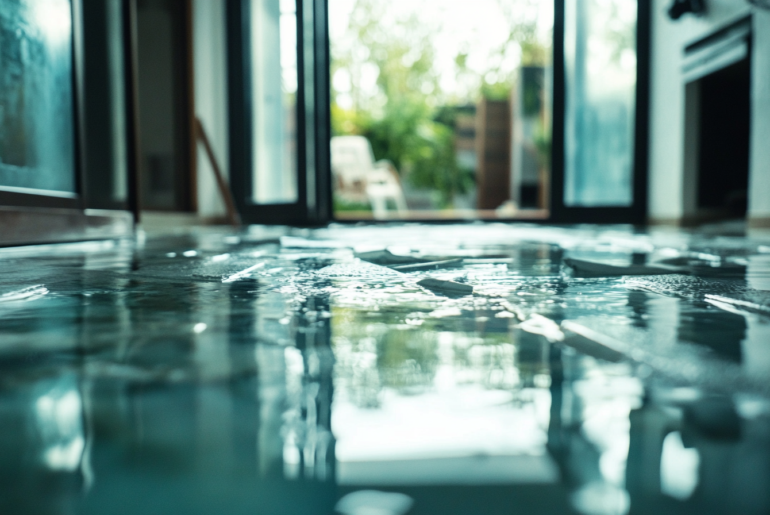This article may contain references to products or services from one or more of our advertisers or partners. We may receive compensation when you click on links to those products or services. Nonetheless, our opinions are our own.
The information presented in this article is accurate to the best of our knowledge at the time of publication. However, information is subject to change, and no guarantees are made about the continued accuracy or completeness of this content after its publication date.
Key Highlights
- Understanding your homeowners insurance policy is very important when you have water damage.
- Coverage for water damage can vary based on the cause, such as burst pipes, roof leaks, or flooding.
- It’s important to document the damage carefully. Use photos and videos to help with the claims process.
- Act quickly to prevent further damage. If possible, stop the source of the water.
- Be ready to provide your insurance provider with all necessary documents and work closely with the claims adjuster.
Introduction
Dealing with water damage in your home can feel overwhelming, especially when navigating insurance policies. Many homeowners are unsure about what their insurance covers regarding water damage. This guide will help you understand water damage claims, what is typically covered, what is not covered, and the steps to file a claim correctly.
Understanding Water Damage and Insurance Coverage
Water damage is a common issue for homeowners and can occur due to minor leaks or severe flooding. These problems often lead to costly repairs and potential health risks.
Understanding your homeowners insurance policy is essential when dealing with water damage. Coverage can be complicated and depends on the cause of the damage and the specifics of your policy.
Types of Water Damage: An Overview
Water damage can occur in several ways, each affecting insurance coverage differently. Here are some common types:
- Sudden and Accidental Damage: Includes unexpected events such as burst pipes, leaking water heaters, or roof leaks from storms. Most homeowner’s insurance policies cover these issues because they are unforeseen.
- Gradual Damage: Occurs over time, such as slow leaks from pipes behind walls or under sinks. Insurance companies may consider this preventable through regular maintenance and may not provide full coverage.
- Flood Damage: Flooding from storms, heavy rain, or overflowing rivers typically requires a separate flood insurance policy. Standard homeowners insurance policies usually do not cover flood damage.
Reading Your Insurance Policy: The Key to Knowing Your Coverage
Reviewing your homeowners policy is essential to understanding your coverage. Insurance policies are legal documents, so it is important to understand terms like “covered peril.”
Examine the sections related to water damage, focusing on exclusions and limitations. Some policies may not cover damage resulting from neglect or lack of maintenance.
If you are unsure about your coverage or have specific questions, contact your insurance provider for clarification. Knowing what your policy includes before an emergency can save you time, money, and stress.
Voted "Best Overall Budgeting App" by Forbes and WSJ
Monarch Money helps you budget, track spending, set goals, and plan your financial future—all in one app.
Get 50% OFF your first year with code MONARCHVIP
Preparing to File a Water Damage Claim
Handling water damage can be stressful, but acting quickly and staying prepared can streamline the claims process. Here are the essential steps to take when preparing for a water damage claim.
Documentation Essentials: What You Need to Gather
Proper documentation strengthens your insurance claim, especially for water damage. Clear proof of the extent of the damage is crucial.
Start by taking high-quality photos and videos of the affected areas and documenting any damaged personal property. Here’s what to include:
- Photos and videos showing the damage up close
- A list of damaged personal property with descriptions and estimated values
- Relevant receipts or bills for repairs or replacements
- Detailed notes from all conversations with your insurance provider
Having organized documentation makes the claims process smoother and strengthens your case for reimbursement.
Identifying the Source of Water Damage
Finding the source of the water damage is essential for both repairs and insurance claims. The cause of the damage affects coverage, especially if the insurer considers it a maintenance issue rather than a sudden event.
If you identify the source, such as a burst pipe or a damaged appliance, document it with photos and videos. If you cannot determine the cause, consider hiring a plumber or water damage restoration expert.
Knowing the cause helps you report the issue accurately to your insurance company and improves your claim.
Step-by-Step Guide to Filing a Water Damage Claim
Filing a water damage insurance claim can be complex, but following clear steps can simplify the process. Stay in contact with your insurance provider throughout to ensure a smooth experience.
Step 1: Stop the Source of Water (If Possible)
Preventing further damage is the first step. If the source is a burst pipe, leaking roof, or failed sump pump, take immediate action to stop the water. This step is critical before filing a claim or beginning repairs.
Step 2: Document the Extent of Damage
After stopping the water source, thoroughly document the damage. Take photos and videos showing the full scope of the damage, including structural issues such as warped floors, damaged walls, or stained ceilings. Also, document damaged personal property.
Continue documenting any changes to the damage over time, even after the initial cleanup.
Step 3: Contact Your Insurance Company
Once you have stopped further damage and gathered necessary documentation, notify your insurance company to begin the claims process.
Most insurers offer 24/7 hotlines and online portals for filing claims. Be prepared to provide your policy number, contact details, a description of what happened, and an estimated timeframe of the damage.
Your insurance agent will guide you through the next steps, including scheduling a claims adjuster visit.
Step 4: Meet with the Claims Adjuster
Your insurer will assign a claims adjuster to assess the damage. The adjuster will inspect your property, take measurements, and gather information for your claim.
Be prepared to provide documentation, including photos, videos, and a list of damaged items. The adjuster’s assessment determines your coverage and settlement amount. You will receive a written report detailing their findings and estimated repair costs.
Step 5: Finalize the Claim and Start Repairs
After the adjuster’s assessment, you will receive a settlement offer. Review the offer carefully, comparing it with your documentation and repair estimates.
If you disagree with the settlement amount, discuss it with your insurer. Ensure additional living expenses are included if you need to relocate temporarily due to severe damage.
Once you agree on a settlement, begin repairs with licensed and insured contractors. Keep all receipts and invoices organized, and stay in contact with your insurer throughout the repair process.
Common Challenges in Water Damage Claims
Insurance claims for water damage should be straightforward, but many policyholders encounter difficulties. Disputes often arise over coverage, settlement amounts, and repair processes.
Disputes over Covered Perils and Exclusions
One common issue is disagreement over what qualifies as a “covered peril.” Homeowners insurance policies usually list covered perils, such as sudden pipe bursts or storm-related damage. However, exclusions, such as floods or long-term neglect, often lead to claim denials.
Homeowners must prove that the damage was caused by a covered peril. If unclear, insurers may deny claims by citing exclusions or arguing the damage was preventable.
If your claim is denied unfairly or you disagree with your insurer’s interpretation, consider consulting a lawyer who specializes in insurance claims.
The Importance of Accurate Documentation
Maintaining detailed records is essential throughout the claims process. Document everything from the initial report to discussions with the adjuster and repair details. Keeping thorough records strengthens your claim and helps resolve disputes.
Organize copies of claim forms, correspondence, photos, repair estimates, and receipts. Proper documentation is especially important for mold-related claims, as proving mold growth and related damage can be challenging.
Conclusion
Understanding how to handle water damage claims is essential for protecting your property. Keeping accurate records, acting quickly, and communicating effectively with your insurance provider can streamline the claims process.
Start by stopping the water source, thoroughly documenting the damage, and notifying your insurer promptly. Being proactive and organized ensures a smoother claim experience and faster repairs. If you encounter difficulties, seek professional assistance to protect your interests.
Frequently Asked Questions
What is the most common cause of water damage claims?
Burst pipes are a frequent cause of water damage claims, especially in colder months. Other common causes include heavy rain, roof leaks, sump pump failures, and appliance malfunctions.
How long do I have to file a water damage claim?
Filing deadlines vary by policy and state regulations. Most insurers require prompt reporting, so it is best to notify your provider as soon as possible.
Are flood damages covered under standard homeowners insurance?
No, flood damage is typically not covered. Separate flood insurance is required, usually available through the National Flood Insurance Program (NFIP) or private insurers.
What should I do if my claim is denied?
Request a written explanation for the denial and consider hiring a public adjuster or legal expert if you believe your claim was unfairly rejected.
Can I hire a professional for water damage assessment?
Yes, hiring a professional can help identify hidden damage and provide accurate repair estimates, strengthening your insurance claim.

Reviewed and edited by Albert Fang.
See a typo or want to suggest an edit/revision to the content? Use the contact us form to provide feedback.
At FangWallet, we value editorial integrity and open collaboration in curating quality content for readers to enjoy. Much appreciated for the assist.
Did you like our article and find it insightful? We encourage sharing the article link with family and friends to benefit as well - better yet, sharing on social media. Thank you for the support! 🍉
Article Title: Water Damage Claims: What’s Covered and What’s Not?
https://fangwallet.com/2025/03/12/water-damage-claims/The FangWallet Promise
FangWallet is an editorially independent resource - founded on breaking down challenging financial concepts for anyone to understand since 2014. While we adhere to editorial integrity, note that this post may contain references to products from our partners.
The FangWallet promise is always to have your best interest in mind and be transparent and honest about the financial picture.
Become an Insider

Subscribe to get a free daily budget planner printable to help get your money on track!
Make passive money the right way. No spam.
Editorial Disclaimer: The editorial content on this page is not provided by any of the companies mentioned. The opinions expressed here are the author's alone.
The content of this website is for informational purposes only and does not represent investment advice, or an offer or solicitation to buy or sell any security, investment, or product. Investors are encouraged to do their own due diligence, and, if necessary, consult professional advising before making any investment decisions. Investing involves a high degree of risk, and financial losses may occur including the potential loss of principal.
Source Citation References:
+ Inspo
There are no additional citations or references to note for this article at this time.












































